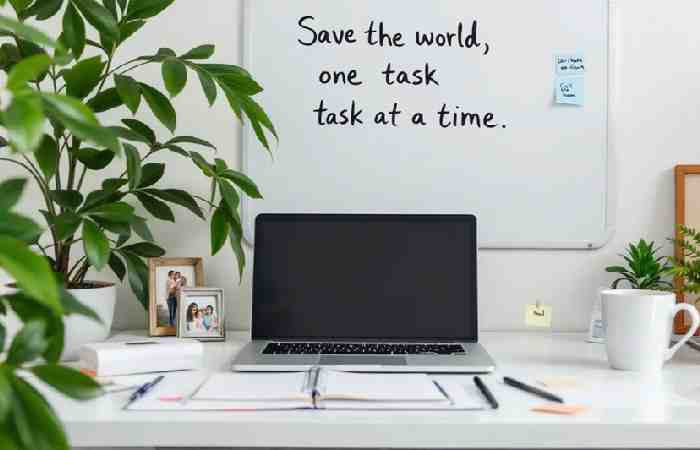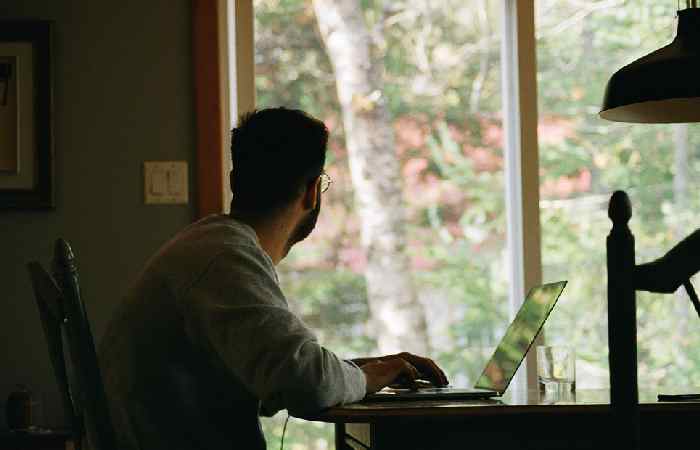
The rise in remote work has brought with it a myriad of benefits, such as increased flexibility and the elimination of daily commutes. However, it has also blurred the boundaries between work-related and personal life, making it harder to achieve a good work-life balance. It’s no longer about clocking out and driving home; your office is your living room, your kitchen, or a corner of your bedroom, which can also be a benefit.
Creating a home life environment that fosters balance is vital. Without distinct separations between work hours and personal activities, you might easily fall into poor work-life balance, which can lead to negative consequences such as burnout and decreased job satisfaction.
A well-designed space—physically and mentally—can make work-life balance achievable at home. Intentional steps in designing your environment can boost productivity, enhance mental well-being, and help reclaim your personal life.
Understanding the Concept of “Space” in Work-Life Balance
Work-life balance requires redefining the concept of “space.” It involves:
- The physical layout of your home office
- Time boundaries
- Digital tools
- Mental well-being
Each element is essential for creating an environment where you can thrive both as an involved person and professionally.
Establishing clear zones and routines within your home can lead to higher productivity, improved mental and physical health, and better relationships.
For instance, having a dedicated workspace can signal to your brain that it’s time to focus, while designated relaxation areas can help you unwind after a long day.
Understanding and implementing these concepts can improve work life balance, leading to greater job and overall life satisfaction. The goal is to create a harmonious blend where work and life complement each other rather than compete.
Creating a Productive Physical Workspace

Designating a dedicated work area is crucial for achieving a healthy work-life balance while working remotely. Consider the following tips:
- Choose a distraction-free space.
- Organize the space to suit your workflow.
- Optimize natural light.
- Minimize clutter to boost productivity and focus.
Ergonomic and functional furniture is essential. Key elements include:
- Comfortable seating and a proper desk setup to prevent fatigue and help maintain focus throughout the day.
- Physical comfort, which directly impacts work performance and overall well-being.
- Implementing storage solutions to keep your workspace tidy, reducing stress and increasing efficiency.
Signaling transitions between work and home helps maintain balance. Small design elements like changing lighting, playing specific music, or even using scents can mark the beginning and end of your workday. These “transition moments” help your mind switch gears and maintain a clear boundary between professional and personal life, making a huge difference.
Creating a productive physical workspace sets the foundation for a more balanced and fulfilling work life. Intentional choices that support productivity and well-being are key.
Digital Space: Tools That Streamline Your Day
In the digital age, your workspace includes digital tools that can streamline your day. Smart scheduling and focus apps block distractions and enhance productivity. Timers and planners to enforce breaks ensure you take necessary short breaks, keeping you focused and reducing burnout in the long run.
Specialized tools tailored to your industry also play a significant role. For instance, software for NDIS providers like iinsight® can streamline daily operations, reducing administrative load and freeing up time for personal priorities. This not only improves work performance but also allows many professionals more personal time, positively impacting overall well-being.
Integrating these digital tools into your routine enhances productivity and helps maintain a better work-life balance. Leveraging technology allows you to work smarter, not harder.
Lifestyle Enhancements That Support Balance
Incorporating lifestyle enhancements into your daily routine is key to achieving a good work-life balance. Setting the mood with self-care products can make a significant difference. For example, starting or ending your work-from-home day with a calming shower using ELEVEN hair products can provide a refreshing way to pamper yourself.
Integrating well-being into your workspace is also important. Consider keeping the following within reach:
- Water
- Healthy snacks
- A yoga mat
- A mindfulness corner
Reminders to stretch, hydrate, or step outside can positively impact mental well-being and reduce stress management, especially when individuals happen to feel stressed.
These small lifestyle enhancements can help avoid burnout and maintain a healthy work-life balance. Creating an environment that supports physical and mental well-being enhances the ability to balance work responsibilities with personal activities and can lead to positive effects.
Establishing Mental Boundaries

Establishing mental boundaries is crucial for maintaining mental health and well-being. Start by setting clear work hours and using digital calendars to block off time and communicate availability. Maintaining a consistent end to the day helps reinforce these boundaries.
Creating a mental “commute” can help transition in and out of work mode. Mindfulness exercises, walks, or listening to music can serve as a buffer between professional and personal life. This mental shift is essential for maintaining focus and avoiding burnout.
Communication reinforces these boundaries. Talk with housemates or family about work hours and space. Use visual cues like headphones or signs to indicate when focus is needed. These strategies help create a supportive environment where mental well-being is prioritized.
Incorporating Life into Your Workspace
Achieving a better work-life balance requires prioritizing what matters most to you. Schedule family time, hobbies, and rest to ensure one’s personal life doesn’t get overshadowed by work. Emphasizing quality over quantity in personal activities can lead to a more fulfilling life, especially when work takes precedence. Taking time to achieve work life balance, focus on integrating these elements into your daily routine.
Bringing joy into your workspace boosts morale and reduces stress. Include meaningful items like photos, plants, and art in your work area. Personalizing your space makes it more enjoyable and can positively impact work performance and overall well-being.
Taking breaks that truly disconnect you from work is vital. Encourage lunch breaks outdoors or with others to refresh your mind and body. Stepping outside to cook on a BBQ grill offers both a culinary break and social bonding, along with small breaks to recharge.
Incorporating life into your workspace creates a balanced environment where work and personal lives coexist harmoniously. Make your workspace a reflection of your life and values.
Employer Support and Remote Culture
Employer support and remote culture significantly impact achieving a healthy work-life balance. Essential components include:
- Flexible scheduling
- Mental health support
- A work-life culture When companies prioritize these elements, they create an environment where employees can thrive both professionally and personally.
Remote-first organizations that champion balance often see reduced burnout and increased retention. Defining boundaries and providing necessary support helps employees maintain a good work-life balance, leading to better job performance and job satisfaction.
Advocating for and implementing these practices allows companies to foster a culture that supports work-life balance, benefiting both employees and the organization as a whole.
The Power of Hobbies and Social Connection

Exploring new or returning to old hobbies can significantly enhance work-life balance. Hobbies help decompress, inspire creativity, and connect with others. Engaging in activities such as:
- Painting
- Music
- Gardening
- BBQ hosting provides a welcome break from work and enriches personal life.
Research shows that hobbies and social connections lead to a greater sense of more control and improved mental well-being. Recent research indicates that making time for personal activities can reduce stress and enhance overall quality of life.
Incorporating hobbies and social connections into your routine leads to a healthier work-life balance. Finding joy and fulfillment outside of work can positively impact your professional and personal life.
Conclusion: Your Space, Your Balance
Achieving work-life balance isn’t about perfection; it’s about intention. Crafting an environment that supports professional and personal needs allows you to live and work with purpose, creating the perfect balance of success.
Take small, consistent steps toward creating a home space that works for you. Your space reflects your life, and intentional choices can take time to lead to a better work-life balance. When you spend time making these choices, you enhance your overall life balance.
Summary
In summary, achieving a healthy work-life balance while working remotely involves intentional steps to create a supportive environment. From setting up a productive physical workspace to incorporating digital tools, lifestyle enhancements, and mental boundaries, these strategies can help you thrive both professionally and personally.
By prioritizing what matters, bringing joy into your workspace, and leveraging employer support, you can achieve a balance that enhances your overall well-being. Take time to make these changes, and remember, a well-crafted environment can make a significant difference in your work-life balance.
Frequently Asked Questions
How can I improve my work-life balance while working remotely?
To improve your work-life balance while working remotely, establish a dedicated workspace and set clear work hours. Incorporate lifestyle enhancements to support your well-being.
What digital tools can help streamline my workday?
Smart scheduling and focus apps can effectively reduce distractions, while industry-specific tools like iinsight® can further enhance your efficiency. Incorporating these digital solutions into your workday will streamline your tasks significantly.
How can I set mental boundaries while working from home?
To set mental boundaries while working from home, establish clear work hours and communicate these with those around you. Incorporating mindfulness exercises can help create a distinct separation between work and personal time. This approach helps maintain focus and well-being.
What role do employers play in supporting work-life balance?
Employers play a crucial role in supporting work-life balance by offering flexible scheduling and mental health resources, while also promoting a culture that values personal time and well-being. This approach not only enhances employee satisfaction but also boosts overall productivity.
How do hobbies and social connections impact work-life balance?
Hobbies and social connections significantly enhance work-life balance by reducing stress and fostering creativity, leading to improved mental well-being. Prioritizing these activities can result in a healthier, more fulfilling lifestyle.